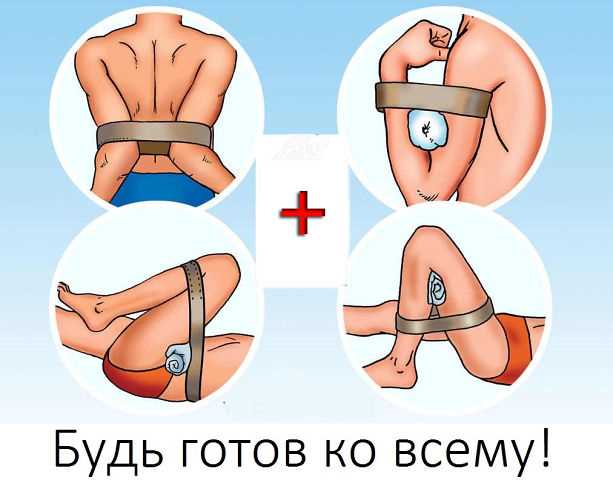In most cases, stab-cut injuries are accompanied by bleeding. Bleeding is different, depending on the wound: arterial, venous and capillary.
arterial bleeding. It is the most dangerous, occurs when the arteries are damaged. Characterized by the fact that the blood flows in a strong pulsating jet and has scarlet color. Damage to large arteries can lead to death if the necessary medical care is not provided to him in a timely manner. With such an injury to large arteries located in the limbs, it is often necessary to resort to applying a tourniquet.
Then the treatment usually takes the form of a sexual fast - at least two days, and then use marigold, chamomile or hemp ointment. Inflammation of the lymphatic vessels of the penis - frequent irritation and lengthening of the penis can lead to inflammation. And here the best treatment is for a few days to a few weeks of abstinence, when the inflammation subsides on its own.
Vaginal cramp - sometimes it happens that the cramp of the muscles of the vagina literally sharpen the man's penis into the vagina. The cramps usually go away after a while, but there are even cases where the only person who helps is a third person in the form of a doctor who has to stab the woman with an injection to relax the muscles.
Venous bleeding. Occurring when the veins are damaged, it is characterized by the fact that the blood flows in a less strong, uniform stream and has dark color. In most cases, venous bleeding can be stopped by applying a pressure bandage.
capillary bleeding. Occurs when the smallest blood vessels-capillaries are damaged. It is characterized by the appearance of many drops of blood on the surface of the wound. Capillary bleeding tends to spontaneously stop and stops when a bandage is applied to the wound.
Blowing - Sometimes a man can come up with an absolutely stupid idea, blowing into a woman's vagina. But the consequences can be very unpleasant. Namely, the air has nowhere to escape, and thus spreads very quickly to the fallopian tubes and uterus in the stomach and intestines. As a result, he may experience pain that resembles appendicitis or a gallbladder attack.
There is also a pulmonary embolism, like a detachment of part of the uterine cavity may be an air bubble will enter the bloodstream. Most often during sex damaging things like bed, glasses of wine or beer, paintings and chairs. The exception did not even accidentally cause holes in the walls, destroyed cabinets or broken doors.
Distinguish the final and temporary stop of bleeding. The final stop of bleeding is carried out by a doctor in a medical institution. When providing first aid, a temporary stop of bleeding is performed. The choice of temporary stop method depends on the nature and strength of bleeding.
Types of bleeding stop:
First aid procedure for major accidents, car accidents, poles In the event of a major accident, it is necessary to deal with the most injured at the same time. Here is a determined calm, systematic approach and an attractive colleague. Property is also self-protection.
In the case of a large number of rescuers, it would be better if they took the lead. The first goal is to ensure that the security forces are aware of the situation and, if possible, the safety of the scene. If you notice a danger, report it immediately.
- applying a pressure bandage
- tourniquet
- pressing the artery with fingers to the bone for
- maximum flexion of the limb and its fixation in this position
The pressure bandage is applied as follows. A cotton-gauze pad of an individual dressing bag is applied to a bleeding wound and secured with tight bandages. Before bandaging, it is recommended to put a ball of cotton wool or a tightly folded cotton-gauze pad from another individual package on top of the cotton-gauze pad covering the wound. The limbs, on which a pressure bandage is applied, are given an elevated position. To do this, the arm is hung on a bandage to the neck, and a folded overcoat is placed under the leg. By means of a pressure bandage, it is possible to stop venous bleeding in most cases, and in cases where small arteries are damaged, arterial bleeding as well.
If the scene of the accident is safe, you can begin to administer first aid and repair wounds. The priority is to contain your life-threatening builders by letting them out of the crash site. After the arrival of rescue units, follow the instructions of the commander.
The most important thing is the safety of the savior! Locate the accident site. Take care of your own safety - keep your vehicle safe when you are on the road. If it is safe to do so, secure vehicles against traffic and turn off the ignition. Beware of potential dangers. If it is not necessary, do not move with people in vehicles. As a result, there is a need for manipulation to ensure that saving resistances are maintained - in this case, try to correct as much as possible of the poisoning Pope.

For bleeding from medium and large arteries, when the blood cannot be stopped with a pressure bandage, a tourniquet is applied. In doing so, the following must be remembered. First, the application of a tourniquet for a continuous period of more than two hours can cause necrosis of the limb; secondly, if the tourniquet is overtightened, nerve damage can occur, resulting in paralysis of the limb; thirdly, due to the imposition of a tourniquet, the blood supply to the peripheral part of the limb stops, which predisposes to the development of pyogenic microbes in the wound. Therefore, a tourniquet should not be used for bleeding that can be controlled by applying a pressure bandage.
If it's safe to do so, remove the exposed objects from the range. You will put out the burnout of the affected person so that if you can wrap him in a thick cloth, you sweep him to the ground until the flames. Dads are one of the most urgent trauma signs in the world. Original: It refers to the most obscure human traumatology, often leaving scars not only physical, but also mental. They use the most complex, durable and simplest. The overall severity of birth is related to volume, depth, age, location, and cause.
Overlay rules:
1. Apply a tourniquet above the wound, but possibly closer to the bleeding wound.
2. Apply a tourniquet directly to clothing.
3. Do not overtighten the tourniquet. The compression caused by the tourniquet must be sufficient to stop the bleeding (before the pulse disappears), but not excessive, otherwise nerve damage may occur.
Determination of the degree of deposit: the size of the fracture site can be guessed according to the so-called nine-rule rule. For small apartments, the ratio is 1% = palm area on one hand. A decrease of more than 15% in adults and 10% in children leads to the development of the organism. The first round of skin turns red and burns intensely. They are fast enough for a few days.
This is the most painful step because there is a back subclass. This is less painful than the other because it causes the receptors that cause pain to be destroyed. It is often necessary to transplant the skin. They remain scars, they are sick of the moon. Note: Sometimes there are grade 4 fissures in the fissure where there is a combination of blisters and initial necrosis and it is completely destroyed by the weft. Age and health of the victim: the worst deaths are with children and the elderly.
4. Apply the tourniquet to the arches for no more than 2 hours.
5. Immediately evacuate the wounded with a tourniquet to a medical facility.
6. When evacuating a wounded person with a tourniquet applied, indicate the date and time of its application so that these data are immediately evident (inscription on the bandage, etc.).
7. If the weather is cold, after applying the tourniquet, warmly wrap the wounded limb.
Lost Traumas: Forgiveness? hands, face and neck, legs and body. Causes of pop-ups: there is always direct contact with the subject, not energy transfer. The solution is the temperature and heat generation time. Hijacking, blowing hot or wet, removing heat from the victim? this is due to the possibility of swelling. It is also necessary to prevent another thermal effect, i.e. to get the victim out of the hot environment.
We cool the best fluid cold water. Will we be sterilized? the best original medical material. If we are talking about a period that has been cured, then we will correct it after the conclusion. We pay special attention to signs and, in case of large spills, preventive measures to deal with shock. With a sterile hand, we masturbate between the fingers.
To stop bleeding, there are special rubber and cloth tourniquets, but when providing self- and mutual assistance, any suitable material (braid, belt, scarf, strip of strong fabric, etc.) is usually used as a tourniquet, tightening the limb with it. A stick is inserted into the loop formed and twisted until the bleeding stops. After that, the ends of the stick are fixed to the limbs with a bandage.
Bloody is undoubtedly one of the most serious and most dangerous injuries, with several reasons why we accept followers. Blood disease is a disease in which blood spontaneously arises from damaged tissue and blood. This suggests that we should bloat right now according to a number of criteria: the type of injury, the location of the injury, and the extent of the injury. In this article, we will focus on the different types of bleeding. We share three main types of bloodshed: blood flow, ooze, and heat.
Cheesecake bleeding is not associated with any great lethargy, it is of course the famous bloody nose. The vein bleeding will stop for some time. Here we can go about injuries of all kinds. It is important to know that the blood flowing from the uterus with this type of bleeding is dark red in color and flows slowly. This bloodshed already requires a conclusion. We must remember that any disinfection does not refer directly to the wound, but only to its environment, because otherwise the injury will be greatly healed.
A temporary stop of bleeding can be achieved by pressing the main arterial trunks with your fingers at some distance from the wound. This method is tedious, but it is of great value as a temporary measure for severe bleeding, carried out before other, more effective measures (for example, applying a tourniquet) are taken. Stopping bleeding by pressing the fingers of a bleeding vessel on the limb is performed above the site of injury - where this vessel can be easily pressed against the bone.
This is the most bloody type of bleeding because it can endure a lot of blood loss very quickly. The blood is red light and rises from the uterus, which can result. We must act very quickly in the heartbeat. First we press the pressure point, and if we try to keep the heart away from the heart, we try to keep it in the box. With these methods, we should be able to change the intensity of bloodshed quite a lot. We'll start again with the bandage. With the correct application of the bandage, we should stop the bleeding.
Bleeding in the hand, forearm, and lower half of the upper arm can be stopped by pressing on the brachial artery. They cover the shoulder from behind with their hand so that the thumb falls at the inner edge of the biceps muscle. Pressing the thumb against the bone, compress the brachial artery.
For bleeding on lower limb compress the femoral artery. To do this, cover with both hands upper part hips at the inguinal fold so that thumbs, laid one on top of the other, turned out to be inside from the midline of the thigh and pressed the artery against the bone.
The use of heaters, an overview of how to use it, how to handle it. Attaching the throat is an unusual and aggressive way of harvesting, but in some cases it is effective. The default is Martin's body, we can improvise with a three-letter tie in a tie and a so-called "sleeve" skirt, etc. Notes: Don't forget to fill the bleeding wound. We do not allow bleeding, except for temporary attachment.
They are used to stop arterial bleeding. These are the places where we can easily locate the original artery and attach it to the bone. With proper compression, immediate bleeding will occur. As for the constant, we hold it above the heart.
In some cases, bleeding on the limb can be stopped by squeezing the vessels by flexing it at the joints as much as possible. In case of injuries to the foot and lower leg, bleeding is stopped by bending the leg at the knee joint so that the lower leg is brought to the thigh, and fixing it in this position; before bending, you need to put an individual dressing bag or a ball of cotton, a handkerchief, etc. into the popliteal fossa.
Head of the carotid artery: press your finger around the hairpin. In case of bruising from the head. Radial artery: We pass the edges of the muscle in the area where the artery runs along the lower edge of the lower abdomen. In case of swelling from the tongue or arteries of the artery Superior cone Lower spine: press down over the key bone in the inner third. In case of bruising from the shoulder, amputation of the upper cone. False artery: we compress the middle third rhythm in the upper third. With high amputation of the lower limb, with gynecological bleeding.
lower limb. Femoral artery. We stand under the middle of a two-inch double leg, amputating the lower limb. In the case of Throat Throat Artery Hemorrhage: We print in the orifice of the hole under the current maximum bend in the knee joint. Hemorrhage is a break in continuity blood vessel and the shedding of blood from this vessel. When the blood flow is slow, it is called bleeding from small vessels.
Bleeding in the area of the hand and forearm can be stopped by bending the arm at the elbow and securing the forearm against the shoulder. Stopping bleeding through maximum flexion in the joints is unacceptable for bone fractures.
In the wounded, who have lost a significant amount of blood, severe phenomena develop due to insufficient supply of blood to the brain. In such cases, to increase blood flow to the brain, the wounded are laid so that the head is lowered and the limbs are raised. To replace the lost blood, the wounded are given to drink again. It is desirable that the drink be warm. The wounded are warmed with warm heating pads and wrapped in overcoats and blankets.
From the outside - when the blood is a blood symbol of sacrifice, purification, martyrdom, initiation, family, kinship. First aid for external bleeding. Bleeding, loss of consciousness, pale mucus, poorly compressed and accelerated heart failure. Heart rate can be best seen on the neck or around the wrist. The pressure should also be checked.
Call for an ambulance, you must dress; To do this. . Pressure points for arterial bleeding. The temple is located in front of the ear, the face under the eyes from the sides of the jaw, the arms above the collarbone, the arms at the crook of the elbow, the palm against the wrist, the thigh in the middle of the groin and upper thigh, the upper part of the knee, the foot, the front of the ankle joint. Read more Glossary of literary terms of the relevant medicines. Physician intervention is also necessary when wounds have occurred as a result of chewing by animals.
Types of bleeding and ways to stop them
Bleeding is called the outflow of blood from the vessels either outward or into any cavities of the body. Bleeding is divided into the following types. Depending on the place of bleeding, they can be:
- external bleeding- these are bleedings that occur when the skin and subcutaneous soft tissues or mucous membranes are damaged and, as a rule, are visible to the naked eye to any person. To detect such bleeding, no medical education, since the poured out blood is seen by both the patient and the people around him.
If after 15 minutes the control of venous bleeding prove that it is still so abundant, you are behind the previous treatment, they narrow the artery that supplies blood to this limb. Failure to first aid can cause the victim's death, therefore. First aid for internal bleeding.
Light oppression pain, pallor of the skin and mucous membranes, palpitations, loss of consciousness or weakness, vomiting in the urine or blood, impaired consciousness. Call the Rescue Service. Position the victim in a supine position with the legs slightly elevated.
- internal bleeding- this is a type of bleeding in which blood is poured either into the lumen of any internal organ(for example, bleeding from the gastrointestinal tract, bleeding from the bladder, uterine bleeding, bleeding from the kidney, etc.), or inside a closed cavity of the human body. An example of such bleeding may be bleeding into the abdominal or chest cavity, bleeding into the cranial cavity, or into the cavity of any joint).
Due to the fact that she cannot be in this form in case of first aid, you need to keep an eye on this person, and if. Stop breathing - Start breathing Breathing respiratory tract- the process of gas exchange between a living organism and the environment. More Biological dictionary artificial.
There will be a pause in the heart - you must start resuscitation. When the patient is not conscious but breathing and has a pulse rate, he should be placed in a safe position. Used in food or drink, move the victim when not required, leaving the victim himself. Your doctor may advise you to have a replacement surgery knee joint if you have severe knee pain and your fitness is limited due to rheumatoid arthritis, osteoarthritis or injury. Replacing your knee will help you get rid of the pain and make you live a fulfilling life.
Also, bleeding is divided depending on the type of damaged vessel from which it arose. According to this principle, bleeding is of the following types:
- arterial bleeding- from the name it is clear that it occurs when an artery is damaged. With arterial bleeding, blood, as a rule, pours out in a pulsating stream, its color is scarlet. Such bleeding is most often life-threatening, as it very quickly leads to bleeding of the human body.
- venous bleeding occur when a vein is damaged. Blood with this type of bleeding pours out with a much less weak pressure, unlike arterial blood, it never pulsates and flows in a continuous stream. Blood, as a rule, has a dark cherry tint. Most often, these bleedings are not threatening, they stop much easier. However, when large veins are injured, they can also lead to rapid bleeding and death if it is not stopped in time.
- capillary bleeding- this is bleeding that occurs with small superficial injuries. At the same time, blood is poured out of many small capillaries. In this case, the entire surface of the wound bleeds, like a sponge. The blood has a bright, as if arterial bleeding scarlet tint. As well as venous, capillary bleeding is rarely life-threatening.
There are many ways to stop bleeding. The choice of the optimal one depends on whether the blood flows outward or inward, and also on whether arterial, venous or capillary bleeding occurs.
If symptoms of internal bleeding are present or even suspected, the patient should be immediately taken to a specialized hospital with a trained surgeon, since absolutely all internal bleeding is potentially life-threatening and often requires emergency surgery (for example, internal bleeding from a ruptured lung or spleen) .
With external bleeding, in the vast majority of cases, even an unprepared person manages to at least temporarily stop the bleeding, which is enough to take the patient to a medical institution without a threat to life, where he will be assisted by professionals in the field of surgery and traumatology. They refer to the basic knowledge of first aid for bleeding and wounds.
Temporary methods to stop external bleeding include the following:
- Applying a rubber band- this method is paramount in arterial bleeding. A tourniquet should be applied above the site of bleeding (for example, if bleeding from the hand or forearm, the tourniquet should be applied to the shoulder; if bleeding from the lower leg, to the thigh, and so on) and tighten it until the bleeding stops.
- Applying a pressure bandage- can and should be used for any bleeding, especially in the absence of a tourniquet. The essence of the method lies in the fact that a lining of a bandage or any clean matter is applied to a bleeding wound, over which a tight bandage is carried out.
- Finger pressing of the arteries. This type of stop bleeding requires certain skills. There are typical places where the arteries are pressed, after which the bleeding stops at least temporarily, but effectively. For example, if you press the femoral artery with your fingers, which is located slightly below the inguinal fold, you can stop almost any bleeding from the lower limb. Finger pressure on the carotid artery on the side of the injury helps stop bleeding on the face or scalp.
Here are some simple ways, if performed in a timely and correct manner, can help save a person's life or prevent the occurrence of severe complications associated with blood loss.
Gastrointestinal bleeding emergency
Acute gastrointestinal bleeding is a complication of more than a hundred diseases of various etiologies. The seriousness of this problem can be indicated by the fact that with late emergency care and late hospitalization of patients with ongoing gastrointestinal bleeding, mortality can be up to 29% of cases.
First aid for bleeding
First aid for bleeding covers not only first aid for bleeding and wounds, but also fractures, including closed injuries. The medical definition of injury sounds like this - it is a sudden impact on the body of an external object that causes anatomical and functional disorders.
Hematoma on the head of a child
A hematoma is a type of bruising. It occurs mainly with closed injuries of tissues and organs and is caused by rupture of blood vessels, as a result of which there is a limited accumulation of blood under the skin or under the periosteum with the resulting cavity containing clotted or liquid blood. Most often in children, hematomas of various localization occur as a result of injuries - domestic or birth in young children, as well as sports, transport, street or school at an older age.
Emergency care for hypertensive crisis
Hypertensive crisis is a condition characterized by a sharp increase in blood pressure above 180/120, or to individually high values. A complicated crisis is accompanied by neurological symptoms - headache, dizziness, paresthesia.
Symptoms of internal bleeding
IN modern surgery special attention is paid to internal bleeding. This is due to the fact that internal bleeding compared to open bleeding is much harder to diagnose. This means that the medical assistance provided may be belated. Internal bleeding is called bleeding, characterized by an outpouring of blood into the natural cavities of the body or artificially created spaces.




